The global blood meal market size is calculated at USD 1.29 billion in 2025 and is forecasted to reach around USD 1.77 billion by 2034, accelerating at a CAGR of 3.63% from 2025 to 2034. The North America market size surpassed USD 450 million in 2024 and is expanding at a CAGR of 3.74% during the forecast period. The market sizing and forecasts are revenue-based (USD Million/Billion), with 2024 as the base year.
The global blood meal market size was accounted for USD 1.24 billion in 2024 and is expected to exceed around USD 1.77 billion by 2034, growing at a CAGR of 3.63% from 2025 to 2034. The blood meal market is growing due to its application, as a source of protein for animal feeds and in the organic farming industry as a fertilizer.
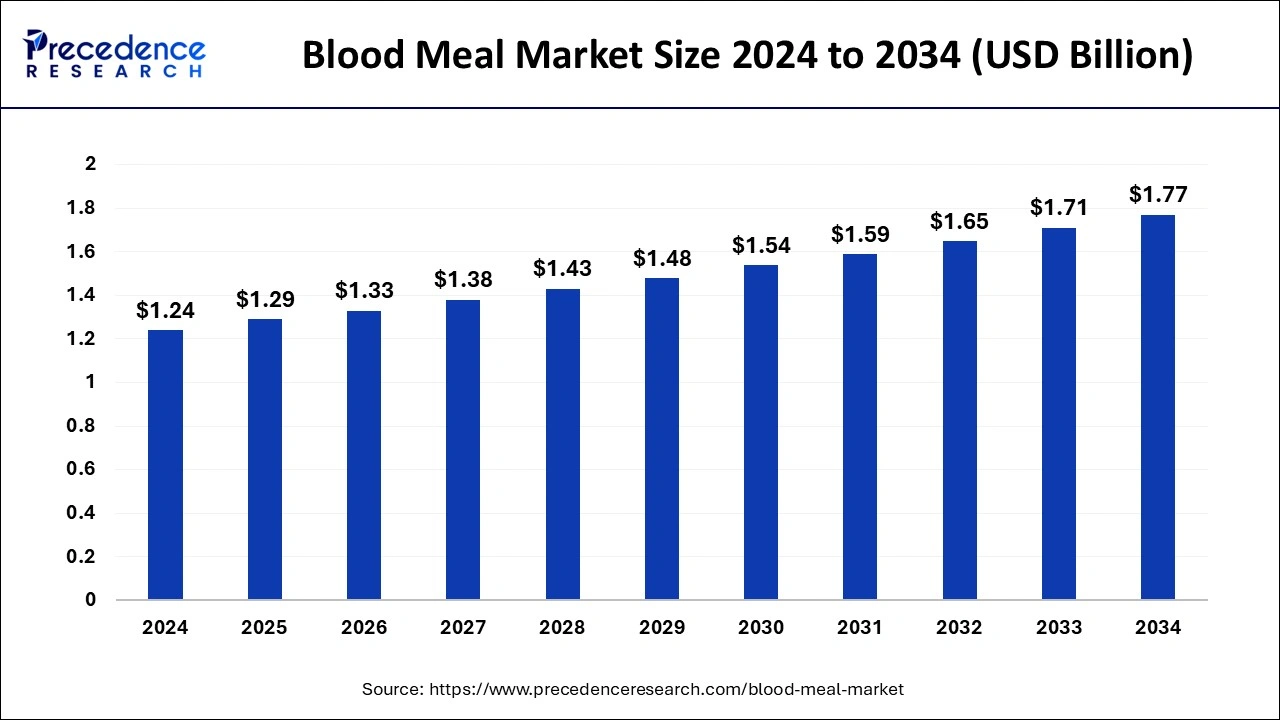
Hardware solutions are physical solutions, including sensors, devices, and components that drive various functions. Applications improve functionality by adding software automation, proper data analysis, and artificial intelligence to make the systems better and smarter. These segments help to solve the needs of the customers, with each type promoting the development of the global blood meal market. Service-based aids focus on support, maintenance, and consulting, ensuring that blood meal systems run smoothly and deliver long-term value.
The U.S. blood meal market size was exhibited at USD 330 million in 2024 and is projected to be worth around USD 490 million by 2034, growing at a CAGR of 4.03% from 2025 to 2034.
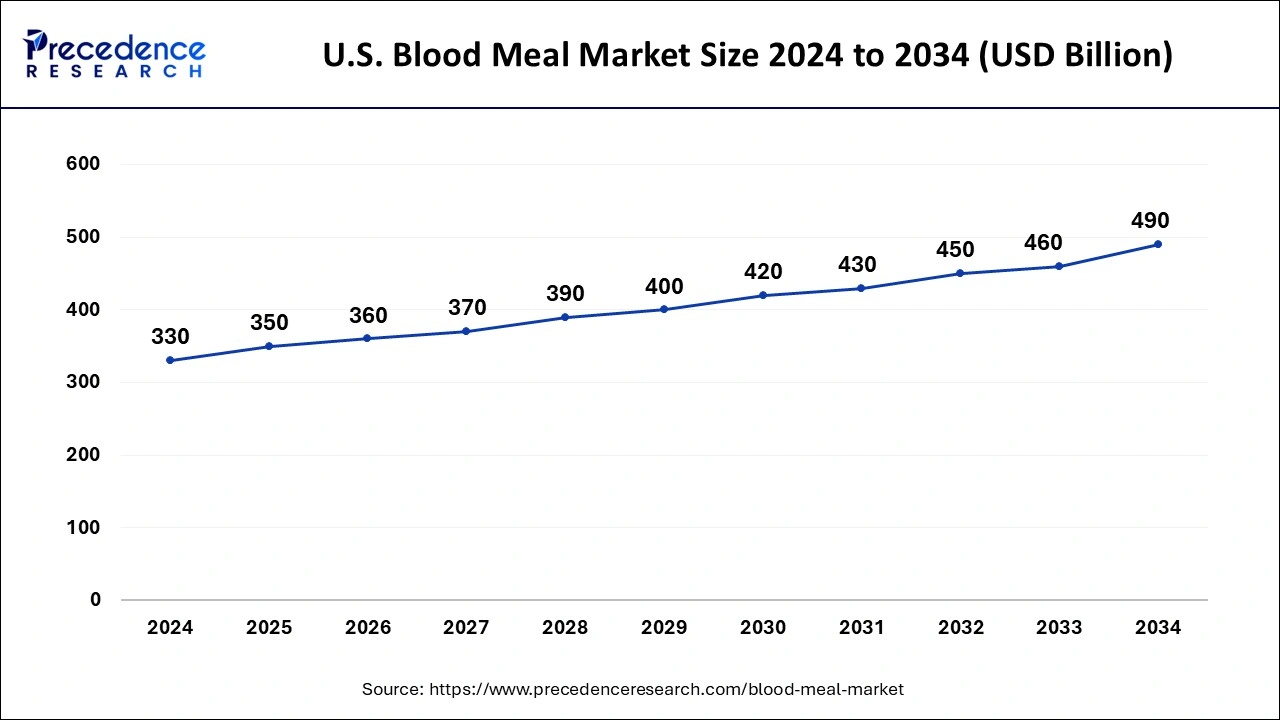
North America accounted for the largest blood meal market share in 2024. The rising demand for blood meal is a result of the growing cattle and poultry industries in the region, which has enhanced the need for high protein animal feed. A blood meal is increasingly used as an organic fertilizer because the legislation for sustainable agriculture and a shift towards organic farming are becoming ever stricter.
The proper use of byproducts in the meat processing industry, especially in the U.S. and Canada, has enhanced the supply of blood meal in North America. North America has a significant status in the growth of the blood meal market because of its excellent and efficient farming practices and developed agriculture industry.
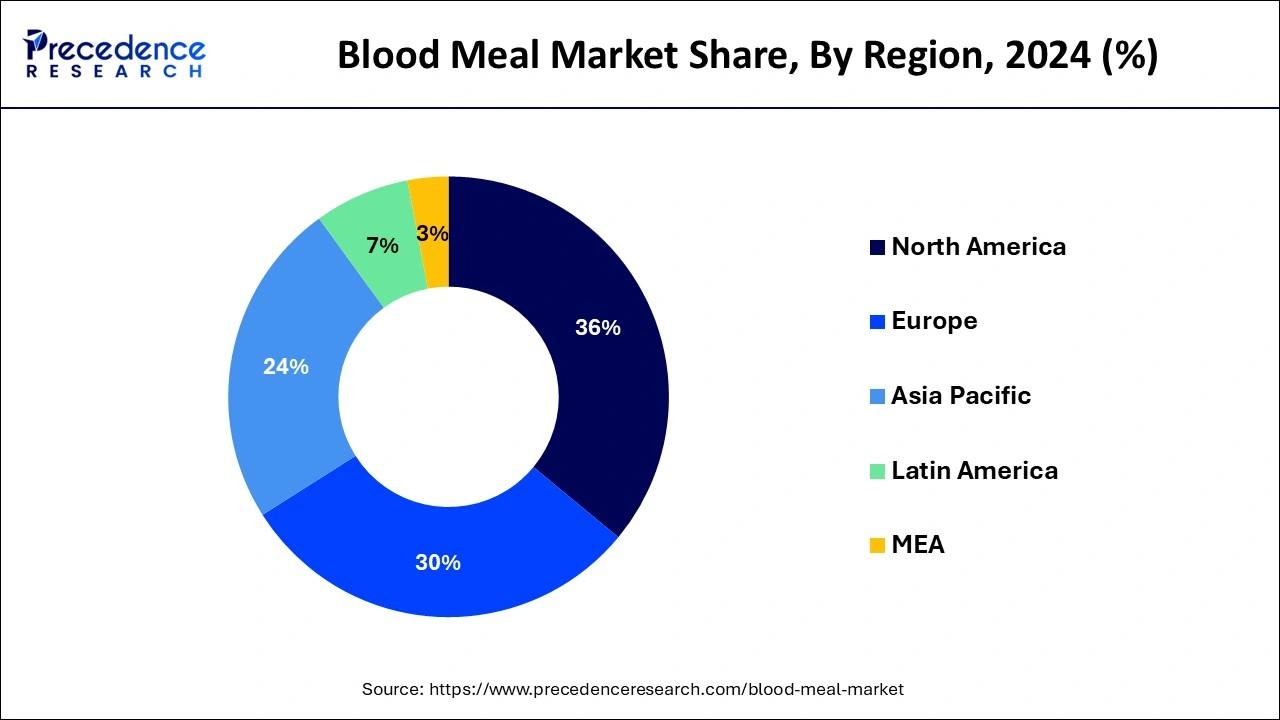
Asia Pacific is anticipated to witness the fastest growth in the blood meal market during the forecasted years. The region, including Japan, Australia, China, and India, become a substantial market. Government initiatives encouraging sustainable agricultural practices also increase the adoption of blood meal as an organic fertilizer.
The Asia Pacific blood meal market is driven by stimulating factors such as higher disposable income, a rise in urbanization, and demand in the feed sector. These countries make up a high percentage of the per capita consumption of meat products like pork, and they are among the big feed producers across the globe.
The blood meal is an inert, dry powder made by drying killed animals' blood and used for a range of purposes. A blood meal is a protein source for animal feed and one of several ingredients that a nutritionist will use to create a balanced meal. The blood is a perishable food product; however, it is collected and processed during the slaughtering of pigs, cattle, chickens, and other animals. Rising demand for premium nutritional components such as protein in the feed for animals, especially fish and livestock.
As the global population continues to increase, the need for inexpensive and effective forms of soil enrichment, like blood meal, will accelerate. The shift in the implementation of organic farming methods, as well as the increase in the demand for eco-friendly agricultural products and equipment, is also boosting the market. This blood meal market plays an important role in organic fertilizer and animal feed industries due to its high nitrogen content for organic farming and protein-rich animal feed supplements. The inclination towards sustainable farming and organic food consumption has significantly improved blood meal demand.
| Report Coverage | Details |
| Market Size by 2024 | USD 1.24 Billion |
| Market Size in 2025 | USD 1.29 Billion |
| Market Size in 2034 | USD 1.77 Billion |
| Market Growth Rate from 2025 to 2034 | CAGR of 3.63% |
| Dominating Region | North America |
| Fastest Growing Region | Asia Pacific |
| Base Year | 2024 |
| Forecast Period | 2025 to 2034 |
| Segments Covered | Source, Process, Application and Regions |
| Regions Covered | North America, Europe, Asia-Pacific, Latin America, and Middle East & Africa |
Growing demand for meat
The blood meal market is driven by the rising demand for animal meat because of the importance of blood meal in animal nutrition, which is high in protein content. Blood meal has a protein content of up to 90% and is loaded with amino acids, which adds an edge over plant proteins. The demand for animal protein products increases, and blood meal is popular in the animal feed industry because of its high protein and low cost.
Due to the ever-growing consumer preference for animal meat and associated products, the degree of animal slaughtering has expanded, creating new opportunities for the blood meal market producers, which play a key role in improving feed efficiency and accelerating growth in poultry, swine and aquaculture. Due to their property as a natural and quality protein source and other nutrients, blood meal is expected to increase market demand due to rises in natural feed additives.
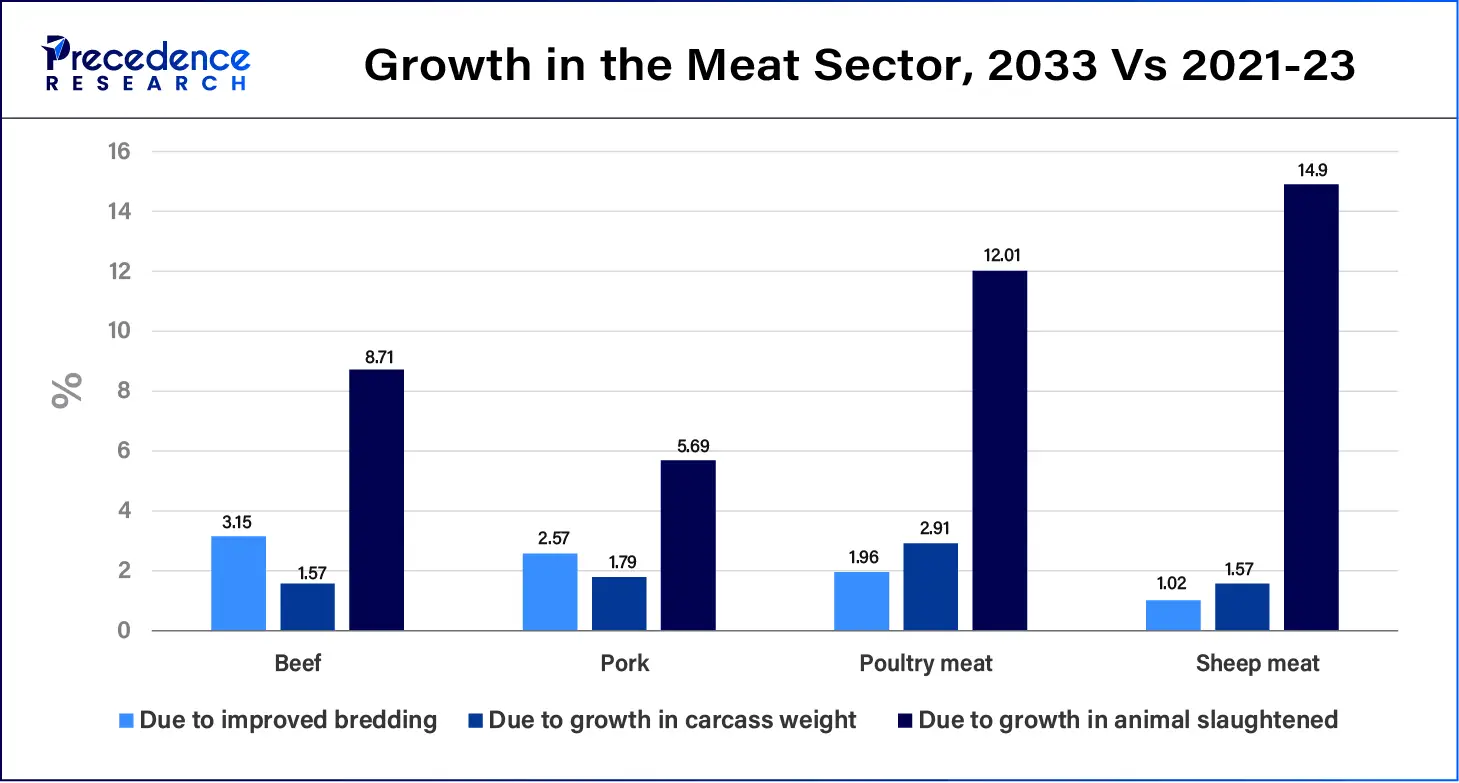
Regulatory and safety concerns
The presence of pathogens and contaminants in blood meal and its utilization in animal feed is hindering the growth of the blood meal market. It may also be disadvantageous for heat stability during processing, leading to the proliferation of pathogenic bacteria or diseases that are dangerous to animals and humans. Blood meal utilization is refined and legal in feeds and organic manure, following the regulation’s guidelines and conditions. Variable regulations across regions, especially those concerning animal byproducts, are challenging.
Increasing awareness of organic fertilizers
The increasing growth in organic farming is considerably driving the blood meal market. As consumers progressively demand organic products, farmers are turning to blood meal organic fertilizer such as blood meal, which is rich in nitrogen. Consumers are opting for organic food products, and their need for organic fertilizers such as blood meal is growing, mainly in countries with large organic agriculture sectors.
Blood meal helps as an organic manure by offering key nutrients such as nitrogen for plant growth. It’s very effective for use in vegetable growing, fruit growing, and flower growing, and it enhances plant health and soil condition; hence, it is useful to organic farmers. Organic farming produces a demand for organic nutrients that will replace the normal inorganic fertilizers in the market.
The poultry blood segment noted the largest share of the blood meal market in 2024. Poultry blood is commonly used and employed to prepare blood meals resulting from its high amino acid value, particularly Lysine. Poultry blood meal is a protein supplement; it is used in feed formulations such as poultry feed, fish feed, and animal feed, which is absorbed by non-ruminant animals. The blood meal has no additives that enhance the natural protein. Consumption of poultry products is persistent in the emerging countries of Asia Pacific, leading to the slaughter of animals. In addition, the growth in the consumption of poultry products is due to the improved demand for protein-rich foods.
The porcine blood segment is projected to witness the fastest growth in the blood meal market during the forecast period. A blood meal is a dry, powdered product derived from animals intended for slaughter and is also a high-nitrogen fertilizer. A porcine blood meal is a high-protein, non-synthetic nitrogen source that is used to feed livestock and used as a fertilizer. Porcine Blood Meal is commonly used as a source of protein in animal feed and is one of many of the ingredients that a nutritionist uses in making a complete feed.
The spray drying segment dominated the global blood meal market in 2024. Spray drying is used in the processing of blood meal, which is a dried product derived from animal blood and commonly used in animal feed production. Moreover, spray drying is also used in the production of spray-dried blood cells and spray-dried plasma that is used in animal feed as it contains nutrients, growth factors, and immune-boosting agents. The associated benefits derived from spray drying, which include the production of an explosion-proof, easily solubilized product.
The poultry feed segment contributed the largest blood meal market share in 2024. The product has substantial traction and is popular as an important feed ingredient in poultry feed due to its beneficial qualities, including better performance and comparatively affordable price. Since people consume more chicken than beef, the need for more poultry production is enhanced. Additionally, innovation in feed formulation makes better high-quality feeds with increased nutritional value and high protein content. Also, the advancement in the levels of chicken farming both in developed and developing countries expands the demand for feeds to be fed by chickens.
The porcine feed segment is projected to witness the fastest growth in the blood meal market during the forecast period. A porcine blood meal is a protein-rich, finely ground powder made from the blood of pigs that is used as an ingredient in animal feed. Spray-dried porcine plasma involves procedures including the blood from slaughtered pigs, an anticoagulant that is normally sodium citrate is added, erythrocytes are then precipitated by centrifuging.
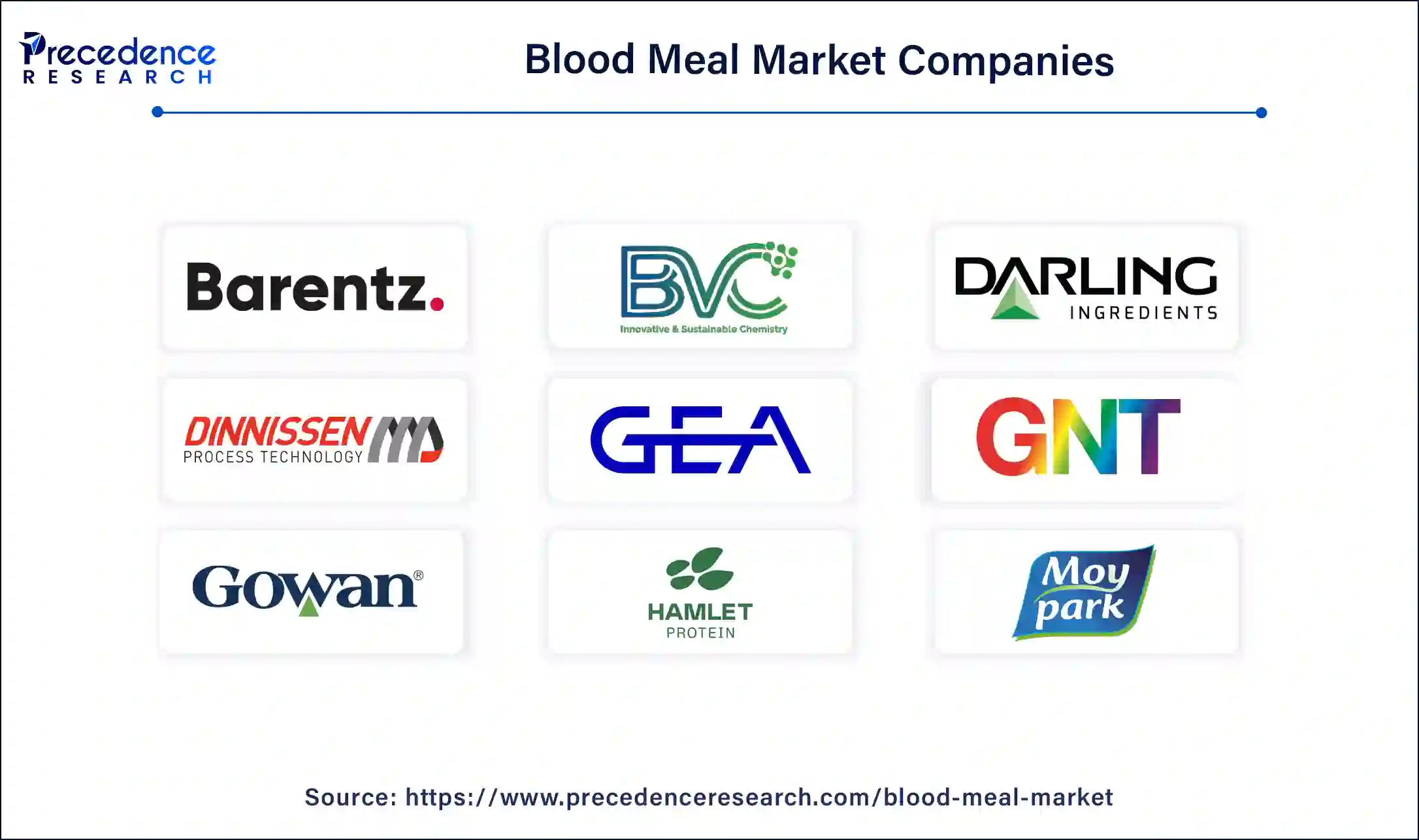
By Source
By Application
By Process
By Geography
For inquiries regarding discounts, bulk purchases, or customization requests, please contact us at sales@precedenceresearch.com
No cookie-cutter, only authentic analysis – take the 1st step to become a Precedence Research client